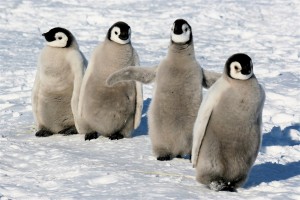12 Facts about Emperor Penguins
Discover the incredible endurance of Earth’s biggest penguins, Emperor Penguins, and how they survive the bitter Antarctic.
While the northern hemisphere experiences winter between December and February, winter in the Antarctic takes place between June and August.
One of the only creatures to endure the -30-degree-Celsius (-22-degree-Fahrenheit) temperatures and 160-kilometre (100-mile)-per-hour winds of Antarctica’s harsh winters is the emperor penguin.The stalwart males in particular spend the entire winter in the unforgiving landscape of the frozen continent’s exposed open ice.
While pretty much all other Antarctic wildlife heads for milder climes, the emperor penguins stick it out. The reason they do this is so that the new chicks will be fully fledged in midsummer when survival rates are much higher.
It’s a treacherous 12 months in the life of an emperor penguin, but their resilience and dedication to caring for a single precious egg for months on end is simply extraordinary.
![Emperor Penguins Facts Emperor Penguins Facts]() Facts about Emperor Penguins
Facts about Emperor Penguins
Feeding: January-February – At the start of the year, the adult emperor penguins head out to sea to ‘east and make the most of the more accessible food in the summer months.
Winter draws in: March – Temperatures begin to plummet from March, and over the coming months the region will be battered by freezing winds and bitterly cold temperatures.
Home to breed: April – The male and female emperors return from feeding and make their way to the breeding grounds in the south. Despite the fact that a colony can contain anywhere up to 12,000 pairs about 15 per cent of couples hook up with their mates from the previous year.
Breeding: May – After mating, the female emperor penguins lay a single egg, which they immediately leave in the safe hands (or perhaps more accurately the ‘safe feet’) of their male partner. With the absence of a nest the male rests the egg on his feet beneath an insulating flap of warm, feathery skin.
Females feed: May – With the egg safely in the care of the males at the breeding ground the females then embark on a treacherous expedition back out to sea. They can trek around 80-160 kilometres (50-100 miles) to the edge of the ice pack in search of vital food.
Incubating: June-July – For nine long weeks each male alone will protect his egg in his brood pouch. During this time he will have nothing to eat and conditions on the ice will grow increasingly hostile. To conserve heat, the fathers huddle in a tightly packed group. Once the penguins on the inside of the huddle have warmed up they will migrate to the outer edge to give other penguins a chance to thaw out. It’s a bit like a penguin conveyor belt.
Hatching: August – In August – usually before the females return home from feeding – the chicks will begin to hatch. To reduce the number of breakages, emperor penguin eggs have an extra-thick shell, which accounts for over one-sixth of the egg’s weight, and it can take several days for the chick to break through. Once hatched the young penguin will maintain its position beneath the flap of skin above the adult’s feet. Any unlucky chicks that fall out of the brood pouch are likely to perish within minutes because of the sub-zero temperatures.
 Females return: September – With their stomachs full the female penguins return to the nesting ground just after the chicks have hatched. Their unique calls help them to locate their mates among the throngs of penguins. Upon being reunited with their young family they will regurgitate a meal stored in their bellies for their chicks.
Females return: September – With their stomachs full the female penguins return to the nesting ground just after the chicks have hatched. Their unique calls help them to locate their mates among the throngs of penguins. Upon being reunited with their young family they will regurgitate a meal stored in their bellies for their chicks.
Males feed: September – Relieved of their chick-sitting duties the male emperors head to sea to forage for themselves. Having shed up to half their body weight they are very hungry indeed. The parents then take it in turns to head off in search of food.
Creches: October-November – As winter begins to subside the growing chicks will leave the warmth of their parents’ brood pouches after about seven weeks. Their downy feathers will moult and their coats will eventually toughen up to form a waterproof covering. To stay warm the chicks huddle in small groups called creches.
Fledged: December – The warmer weather melts the pack ice so that it breaks up, effectively bringing the sea closer to the colony. Fully fledged chicks will now rejoin their parents and take their first dip.

